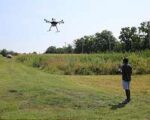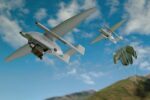The Royal Netherlands Air Force (RNLAF) has officially joined the United States Air Force’s (USAF) Collaborative Combat Aircraft (CCA) program—an ambitious effort to develop AI-enabled unmanned systems that will operate alongside crewed fighters like the F-35 and Next Generation Air Dominance (NGAD) platforms. This marks a significant milestone as the Netherlands becomes the first European country to formally participate in the CCA initiative, signaling growing transatlantic cooperation in next-generation air combat technologies.
What Is the CCA Program?
The USAF’s Collaborative Combat Aircraft program is a central pillar of its broader Next Generation Air Dominance (NGAD) initiative. The CCA concept envisions low-cost attritable or expendable unmanned aerial vehicles (UAVs), often referred to as “loyal wingmen,” that are capable of executing missions such as electronic warfare (EW), intelligence-surveillance-reconnaissance (ISR), suppression of enemy air defenses (SEAD), and even kinetic strike—all while operating semi-autonomously or under human supervision.
These UAVs are intended to fly alongside manned aircraft like the F-35A or future NGAD fighters. The goal is to enhance survivability and lethality by distributing risk across a mix of manned-unmanned teams. The CCA aircraft will leverage artificial intelligence for autonomous decision-making and mission execution under contested conditions.
In March 2023, Secretary of the Air Force Frank Kendall revealed that the service plans to procure at least 1,000 CCAs—roughly two per crewed NGAD fighter and one per F-35A. The program is currently in its technology maturation phase with multiple vendors under contract for design studies and prototyping.
Netherlands’ Strategic Entry into CCA
The Dutch Ministry of Defence announced its participation during a bilateral meeting with U.S. officials in Washington D.C., citing shared operational needs and long-term strategic alignment with U.S. airpower concepts. The agreement allows Dutch personnel to embed within USAF development teams working on CCA design and operational concepts.
This move aligns with broader Dutch defense modernization goals outlined in their “Defensievisie 2035” white paper, which emphasizes increased investment in unmanned systems, AI integration, and multi-domain operations. It also reflects deepening ties between American and European air forces within NATO’s evolving force posture.
“By joining this program early on,” said Dutch State Secretary for Defence Christophe van der Maat, “we ensure our industry and operators are involved from day one in shaping what future air combat looks like.”
NATO Implications: Interoperability & Standardization
The Netherlands’ entry into CCA development has broader implications for NATO interoperability. As one of Europe’s most technologically advanced air forces—and an early adopter of fifth-generation aircraft—the RNLAF brings valuable operational experience with platforms like the F-35A Lightning II.
Participation in CCA will help shape common standards for manned-unmanned teaming across allied forces. It also opens pathways for joint testing environments within NATO’s Combined Air Operations Centres (CAOCs) and exercises such as Air Defender, Baltic Operations, or Red Flag Europe.
This could accelerate convergence around datalink protocols such as Link 16/JREAP-C/IBCS integration; AI trust calibration; common ground control stations; and sovereign mission autonomy frameworks—critical elements if allied CCAs are to operate seamlessly alongside U.S.-led formations.
Industrial Collaboration Opportunities
The partnership also offers opportunities for Dutch aerospace firms—including Fokker Technologies (GKN Aerospace), Thales Nederland, and TNO—to engage with U.S. primes involved in CCA prototyping such as Boeing (MQ-28 Ghost Bat), Kratos Defense & Security Solutions (XQ-58 Valkyrie), General Atomics Aeronautical Systems Inc., Lockheed Martin Skunk Works, Northrop Grumman Aeronautics Systems, Anduril Industries, among others.
- Boeing MQ-28 Ghost Bat: Originally developed with Australia’s RAAF under their Loyal Wingman program; now being evaluated by USAF for potential adaptation into CCA roles.
- Kratos XQ-58 Valkyrie: A low-cost attritable platform already tested by AFRL; designed for modular payload integration including EW pods or mini-munitions.
- Anduril Fury: Recently unveiled stealthy long-range drone optimized for autonomous strike missions; part of DARPA’s LongShot/Offensive Swarm programs overlapping with CCA objectives.
Dutch industry participation could include sensor payload co-development, secure comms architecture contributions based on NATO standards/STANAGs, or even composite materials manufacturing leveraging existing aerospace clusters around Woensdrecht or Papendrecht.
Tactical Use Cases & Operational Concepts
The RNLAF is expected to explore several operational use cases through its involvement:
- Aggressor Decoys: Using CCAs to simulate enemy threats during training or deceive adversary IADS during real-world ops;
- Shooter-Sensor Pairing: Employing CCAs as forward ISR scouts that cue weapons release from standoff F-35s;
- Saturation Attacks: Launching swarms of CCAs equipped with loitering munitions against high-value targets;
- CEMA Missions: Conducting cyber-electromagnetic activities including jamming/spoofing via modular EW pods;
- Aerial Refueling Relays: Acting as comms relays between tankers/fighters during dispersed operations over contested zones;
This experimentation will likely occur at test ranges such as Vliehors Range or via deployments to U.S.-based exercises at Nellis AFB or Eglin AFB where advanced manned-unmanned teaming scenarios are already underway under Project VENOM or Skyborg Vanguard efforts.
A Model for Future Allied Participation?
The Netherlands’ early entry into the CCA ecosystem may serve as a model for other close allies—including Norway, Denmark, Italy or Canada—who operate F-35 fleets and seek greater integration into next-gen unmanned combat aviation initiatives led by Washington.
This trend mirrors similar multinational participation seen in other major U.S.-led programs such as NGI (Next Generation Interceptor), Aegis BMD upgrades via NATO BMD architecture contributions from countries like Spain/Romania/Poland/Turkey—or even earlier examples like JSF international partner tiers during F-35 development phases.
If successful, this could lead to a more coalition-centric approach toward developing interoperable autonomous air combat capabilities across NATO—a necessity given increasing peer threats from Russia’s Okhotnik UCAV family or China’s GJ-11 stealth drones entering service over Asia-Pacific theaters.
Conclusion: Strategic Leap Toward AI-Mediated Airpower
The Netherlands’ decision to join the USAF’s Collaborative Combat Aircraft program represents more than just industrial cooperation—it signals a strategic leap toward embracing AI-mediated warfare concepts that will define future conflicts. By embedding early into doctrinal development loops alongside U.S. partners—and potentially contributing sovereign innovations—the RNLAF positions itself at the forefront of next-generation coalition airpower design.
This move not only strengthens bilateral defense ties but also sets a precedent within NATO for deeper allied participation in unmanned combat aviation programs—where interoperability must be engineered from inception rather than retrofitted post-deployment.









